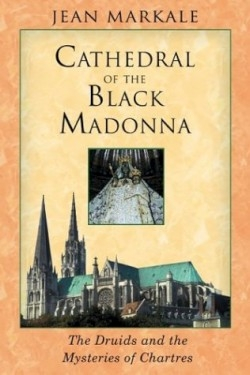Cathedral of the Black Madonna
The Druids and the Mysteries of Chartres
The author, who is a philosopher, historian, and retired teacher of Celtic studies at the Sorbonne, has made a lifes study of the Celts and written numerous books on the subject, including The Druids, Women of the Celts, and Merlin. He combines this interest with another life-long passion, the great cathedral of Chartres, in a book that is overwhelming in its information and detail.
Chartres cathedral is known the world over for its awe-inspiring Gothic architecture, its light-changing stained glass windows, and its labyrinth, which inspired a whole spiritual movement in America. Located in the town of Chartres, the capital of Eure-et-Loire in northwestern France, southwest of Paris, this famous French landmark would not be suspected of having roots in a Druidic past, but such is the case, according to Markale.
His book is divided into three parts: The Sites, The Virgins Great Shadow, and The Mystery of the Druids. In the first section, he gives a detailed description of the cathedral along with an in-depth look at its history and the history of the town, for “Chartres is first a town and this town holds other monuments, other churches.”
In the second section, he examines the history of depicting the Virgin, explaining how images of the Mother Goddess in pagan cults became adapted and accepted into the form of the Virgin Mary. She is depicted as black at Chartres as well as in art of both Christian and pagan cultures all over the world. Markale examines the significance of the Black Madonna, exploring numerous reasons for its black color but finally asserting, “As the Black Madonna, Mary represents all creation before it was created. She is pure potentiality, hence the absence of colors.”
In the third section, he looks at the role of the Druids in the history of this area of France and in the origins of the foundations of the cathedral, arguing that it is built on the site where the Druids celebrated Samhain, the time of the interpenetration of the worlds of the living and the dead, an annual festival that demanded compulsory attendance.
All of this information-mythical, mystical, and historical-is given in extensive breadth and detail that would have been greatly enhanced by maps, photos, and drawings. Even though there is an eight-page insert, illustrations would have been more useful spaced throughout the book for quick and easy reference, especially for those not familiar with French geography or French history, as names of people and places are numerous and can be confusing.
Although not for the neophyte, this book will appeal to the serious scholar and the reader passionate about this unique cathedral; it is rich in information and ideas that can continue to be mined with each successive reading.
Reviewed by
Paula Scardamalia
Disclosure: This article is not an endorsement, but a review. The publisher of this book provided free copies of the book to have their book reviewed by a professional reviewer. No fee was paid by the publisher for this review. Foreword Reviews only recommends books that we love. Foreword Magazine, Inc. is disclosing this in accordance with the Federal Trade Commission’s 16 CFR, Part 255.

